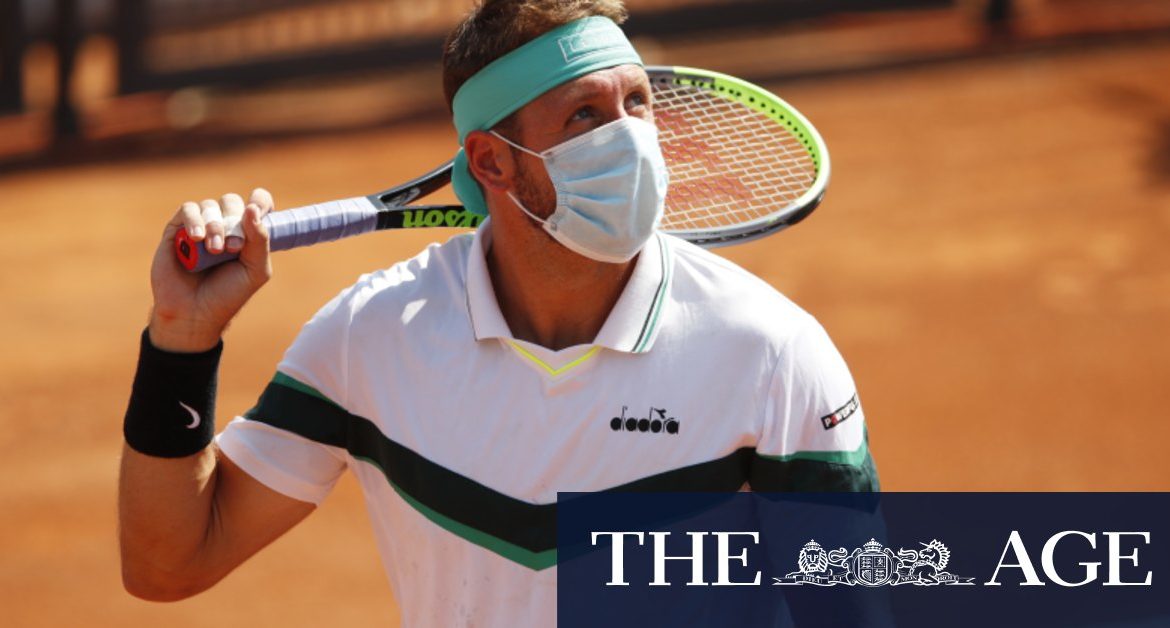The trio – a woman in her 20s and two men in their 30s , are in hotel quarantine.
Another player was believed to have tested positive on Sunday, Professor Sutton said on Monday.
A fourth case reported in hotel quarantine on Tuesday involves a returned traveller in her 30s and health authorities said she was not connected to the tennis tournament.
Mr Tiley said DHHS reported cases when they were acute or incidences of viral shedding.
Loading
When asked specifically if the positive cases included any players, Mr Tiley said: “No”.
“Of those six [cases in the Australian Open contingent], plus one – which was the flight attendant – none of them are players. (It’s) player entourages,” he said.
“There have been some players on the viral shedding list. Again, I’ll have to leave it to Quarantine Victoria to give those numbers. They’re not big numbers. It’s a few.
“As far as [players] testing positive and going to the medi-hotel – no, none.”
People in hotel quarantine are transferred to a medi-hotel if they test positive to the virus, under Victoria’s coronavirus protocols.
Spanish tennis star Roberto Bautista Agut has slammed the Victorian government’s handling of the Australian Open quarantine saga, comparing the lockdown to prison.
In his statement, Professor Sutton also dashed hopes that some tennis players in hard lockdown might have their restrictions eased, after some positive cases were recategorised as viral shedding meaning they were not contagious.
Victorian Premier Daniel Andrews had suggested on Tuesday morning that some of the 70 players confined to their hotel rooms after being deemed close contacts of COVID-19 cases could be released early, because of news that several positive cases had been reclassified.
But Professor Sutton threw cold water on that speculation later in the day.
“While two cases of viral shedding were confirmed yesterday, this does not change [the] broader assessment of the player group in hotel quarantine,” he said in a statement. “As yet, none of the three affected flights have been cleared as a result of the two reclassified cases.”
Professor Sutton said investigations were ongoing to determine if any other cases could be safely reclassified as an earlier infection.
The Health Department is yet to provide information about how they made the decision to reclassify the cases as instances of viral shedding.
However, experts say there is no routine test to determine if someone is shedding coronavirus, rather than actively infected, which means that the cases were likely reclassified because the people who had tested positive could prove they had contracted coronavirus some time ago and therefore were no longer infectious.
Loading
This was the case with American tennis player Tennys Sandgren, who was cleared to fly to Australia last week after a positive COVID test was reviewed by COVID-19 Quarantine Victoria and determined to be a case of viral shedding. He’d previously had coronavirus in November.
The PCR tests typically used in Australia to detect coronavirus are extremely sensitive, to the point that they sometimes can even pick up dead virus, many weeks after the initial positive test.
Leading infectious diseases expert Professor Nigel McMillan said it was possible to grow the virus in the lab to check that the person was not still infectious, such testing was difficult, time-consuming and expensive.
“All health services make the assumption now that unless there’s really an underlying immune deficiency [in the patient] … then you wouldn’t have any reason to suspect that it is not just virus shedding.”
University of Queensland infectious diseases physician Associate Professor Paul Griffin said investigators typically relied on medical information such as when people had COVID-19 symptoms or had initially tested positive to establish whether they still posed an infection risk.
Australian guidelines allow people to be released from quarantine without a negative test in mild coronavirus cases, if 10 days has passed since their first symptoms, or 72 hours after the end of acute illness.
One key exception is patients who test positive to the UK strain, who are required to undergo mandatory 14-day quarantine and will generally need a negative PCR test before they are let into the community.
“Based on that definition, where we need to have a negative PCR [test], it’s very likely some people will have extended periods of ongoing quarantine,” Associate Professor Griffin said.
Aisha Dow reports on health for The Age and is a former city reporter.
Scott Spits is a sports reporter for The Age
Most Viewed in Sport
Loading







